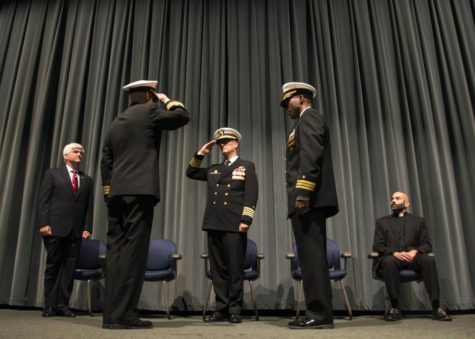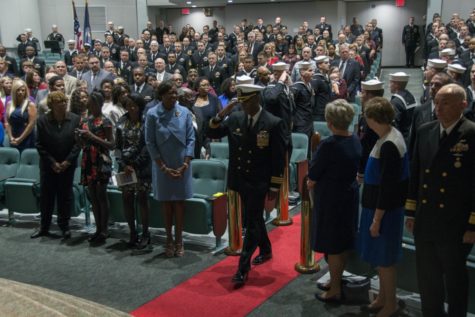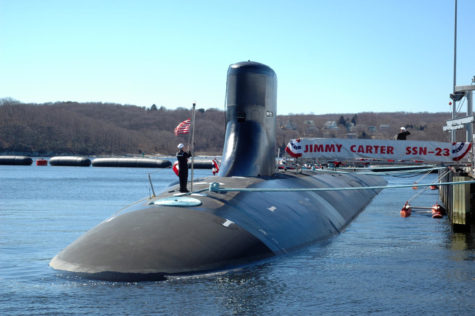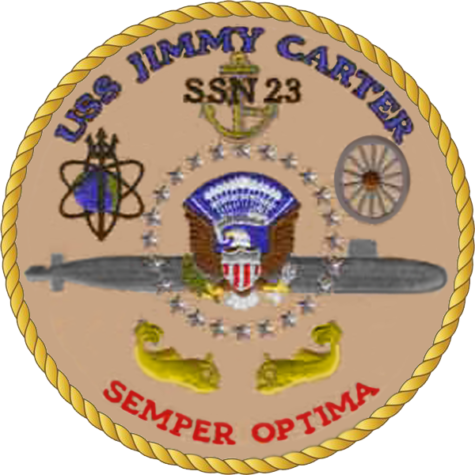Washington Change of Arms Ceremony
October 13, 2017
It all started with a phone call my dad got from one of his friends from college. Keith Floyd, previously a resident from our own town of Rocky Mount, had just been given command of the USS Jimmy Carter, a seawolf class submarine. Of course, the ceremony making this official had not yet happened, and that was something my family could not afford to miss. Weeks of planning went by before everything was finalized, but once it was my family and I headed off all the way to Washington state, where the sub’s base of operations was.
The true changing of arms ceremony happened in an annex of the Navy Undersea museum, located in Keyport, WA, and was a very formal event. The previous commander of the submarine gave a speech thanking the crew for their efforts and loyalty before transferring his command of the submarine to Mr. Floyd. Now Commander Floyd, he gave a speech thanking everyone who helped him on his personal journey to where he is now, as well as a shout out to the Navy band as he was a member himself of the high school marching band.


U.S. Navy photo by Mass Communication Specialist 1st Class Amanda R. Gray/Released; https://www.dvidshub.net/image/3842046/uss-jimmy-carter-ssn-23-welcomes-new-commanding-officer
Following the ceremony there was a short reception where guests could meet each other, but the truly interesting events happened shortly afterward. When the reception ended Commander Floyd escorted my family and a small group to the naval base near the museum. Once past the simple guard station and chain link fence, it was apparent that the complex was a fully functioning city, with everything needed for a life without ever leaving the grounds. Our car drove through well maintained streets and residential areas before finally stopping at a warehouse along the waterfront. As we all filed out we discovered that it was the temporary base of operations for a navy group specializing in unmanned vehicles. Entering the building, the yellow, orange, and grey micro-subs lined the wall, ranging in size and shape. Used mainly for mapping the ocean floor, the smallest was close to two feet long, with others increasing in size until they reached the end of the building. The largest was close to 20+ feet long and required a crane to lift its multi-ton titanium shell for deployment. Many of these subs were open to be modified, and the workers had stations with tools to do so.
While it was interesting to see the unmanned operations, what excited me was the tour happening the next day. We had been given access to tour the USS Jimmy Carter! The submarine is classified as a fast attack submarine, nuclear powered, and is the third and final Seawolf class sub, measuring 100 feet longer than the other two because of its multi mission platform that was added to allow for more diverse missions. The tour started with a descent down a makeshift ladder lowered through the torpedo loading hatch. Inside the sub it was well lit, but had very little headroom (people taller than me had to stoop constantly). Our first stop was the control room. The entire ship could be operated from here, and only needed a minimum of 8 people for it to work. Two drivers steered the submarine and another senior officer watched over them. Other stations included a spot to control various systems and and lots of navigators. Two periscopes dominated the interior, and could be lowered down two stories deep inside the ship when not in use. Connected to the control room was the officer’s’ quarters. While the senior members were given private rooms, they were not built for comfort. The Commander’s quarters were minimal and cramped, but had an insane amount of technology crammed into them allowing him to listen and communicate to the entire ship without ever moving. Continuing down the hall and passing the multi mission platform, we reached the mess hall. Here there was plenty of space for people to eat, and because it was nearly time for the third meal of the day, the ship’s cook had prepared, in my opinion, the best peanut butter cookies I’ve ever had. Seeing the parts of everyday life on a submarine was interesting, but what tour is complete without a visit to the torpedo room! Though empty at the time, the Jimmy Carter had a massive space for storage. On many missions torpedoes were not needed, so this area was used for carrying other items that could make the mission easier. An interesting fact I learned was that the submarine had fewer bunks than it had crew members, and due to this many crewmen slept on mats in the torpedo room instead of having to share a bed during the shift they were given a break from work. The room’s setup was very well thought out. Its storage containers could be moved and replaced with torpedoes. These torpedoes could be loaded into the tubes manually or the entire system could be automated, speeding up their firing rate.

050219-N-9954T-071
Naval Submarine Base Groton, Conn. (Feb. 19, 2005) Ð A Sailor raises the Union Jack aboard the Seawolf-class nuclear-powered attack submarine USS Jimmy Carter (SSN 23) during the submarineÕs commission ceremony. Jimmy Carter is the third and final submarine of the Seawolf-class. A unique feature of the Jimmy Carter is a 100-foot hull extension called the Multi-Mission Platform, which provides enhanced payload capabilities, enabling the submarine to accommodate the advanced technology required to develop and test a new generation of weapons, sensors and undersea vehicles. U.S. Navy photo Photographer’s Mate 2nd Class George Trian (RELEASED)


